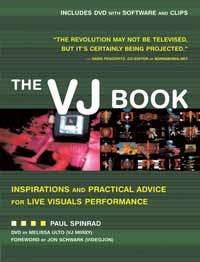 Alongside books about the Suicide Girls, and a DIY guide to everyday chemistry, renegade publishers FeralHouse Press recently released ‘The VJ Book: Inspirations and Practical Advice for Live Visuals Performance’, by Paul Spinrad. Featuring a stack of interviews with long-time and newbie VJs, it’s filled with reference material for would-be Visual Jockeys, and a companion DVD provides examples of good VJ work as well as sample clips and software to play with. Test Drive Below.
Alongside books about the Suicide Girls, and a DIY guide to everyday chemistry, renegade publishers FeralHouse Press recently released ‘The VJ Book: Inspirations and Practical Advice for Live Visuals Performance’, by Paul Spinrad. Featuring a stack of interviews with long-time and newbie VJs, it’s filled with reference material for would-be Visual Jockeys, and a companion DVD provides examples of good VJ work as well as sample clips and software to play with. Test Drive Below.
VJ History
One of the book’s strengths is it’s understanding of Vjing as one end of a continuum that stretches back through the raves of the 90s, the scratched video of the late 80s, through to the colour organs of the 18th and 19th centuries. VJs have new tools now, but visualisation of sound, and live improvisation with light is nearly as old as storytelling or entertainment. Aside from a decent and devoted section to the light-stylers of yesterday, The VJ Book includes plenty of well-seasoned veteran jockeys amongst it’s interviews, so historical anecdotes ooze out of the pages, the trials and tribulations of early electronic VJs documented alongside their crazier experiences and successes.
Alongside the mesmerising colour organs of yesteryear, much description is given of the wet shows of the 50s (swirling liquids and paint in glass bowls above overhead projectors) and Disney’s collaboration with the Philadelphia Orchestra on Fantasia. We go behind the scenes with the club video circuit of the 1970s, and even the Australian designed Fairlight CVI (Computer Video Instrument ) gets covered for it’s role in facilitating real-time video effects back in 1984. As time creeps forward though, the histories presented are mostly from that heartland of stateside counterculture, San Francisco, California – which brings with it necessary limitations, enthusiasms, perspectives.
VJ Anecdote
At the book’s best, it manages to dissect the artform, and provide a variety of frameworks to analyse it from, although there is little critique of the dark sides of VJing : screensaver / wallpaper pixels & fractal nightmares. Let alone a deeper interrogation of what it means to project images in an already image-saturated culture. Henry Warwick does argue within an interview though, that VJ culture is doomed unless it can break away from dance music, and develop an ability to control the audio also.
Celebrating the improvised moving image – the book does well, and rich stories flow continuously from a range of VJs, enough to nurture itchy pixel fingers in the merest of video dabblers. Craig Baldwin, archivist, collage film sampler and producer of ‘Sonic Outlaws’ and ‘Spectres of the Spectrum’ gives typically vivid responses, Stefan G drips with historical perspective, and people like Mark Coniglio ( developer of the Isadora software ) & Jay Smith ( developer of the Livid Union software and the viditar – a midi video guitar ) show the stories behind the evolution of their software and VJ practice.
VJ Reference Guide
A chapter titled the kitchen basics details how to source material, what to look for in laptops, how to connect hardware, useful lists of needed convertor cables, and translators between formats. It explains commonly used equipment such as a scan convertor, distribution amplifiers and includes a range of software reviews ( many of these programs have demo versions on the DVD). Although much of this can be found online, there’s a usefulness of having this sort of information all in one physical place for the potential VJ. And for the seasoned VJ, it looks at lessons learnt from film editing ( action & reaction – juxtaposition, geometry and motion, established settings, stock shots, basic generative grammar),
audience and improvisation, predictions and reflections and has a comprehensive look at legal issues. The legal spotlight is quite useful, given the video world still lags far behind the audio world when it comes to legal infrastructure for playing clips and paying for samples etc. As Craig Baldwin states within his interview though – most VJs safely play sampled footage, and only run into risk when playing either much larger venues, or when broadcasting or turning their work into a DVD like commercial product.
VJ Inspiration
Whether it’s Yusei Horiuchi chatting to a deaf raver on a beach dancefloor about his visuals, Jay Smith waxing lyrical about the joys of having a video performance instrument or Benton C Bainbridge enthusing about various ways of playing with video signals – there’s a certain infectiousness to the VJs interviewed, but although there is a companion disk of clips – it’s a damn shame the book didn’t include *a-single-photograph* on it’s pages. Photos of the VJs interviewed, of their rigs, of them working live of various rare gear etc, all would have contributed much to this book, and there seems something flawed about a book based upon visual improvisation being so lacking in imagery. That said, some of the DVD clips are pretty tasty and they do provide sample software and clips to play with. The Jay Smith demo reel and Josh Goldberg’s clip are probably the stand-outs of the twenty-something clips.
Verdict?
Nice compilation of VJ related thoughts and histories – would’ve been a much stronger book with supporting photos, and a broader look at what real-time video artists are doing – with say live audiovisuals, game engines and interfacing with the real world via sensors and video installations. A broader palette of VJ styles on the companion DVD would’ve been nice too. As it stands though, it lays out a decent road-map for the aspiring VJ, and is the most comprehensive VJ book to date.
